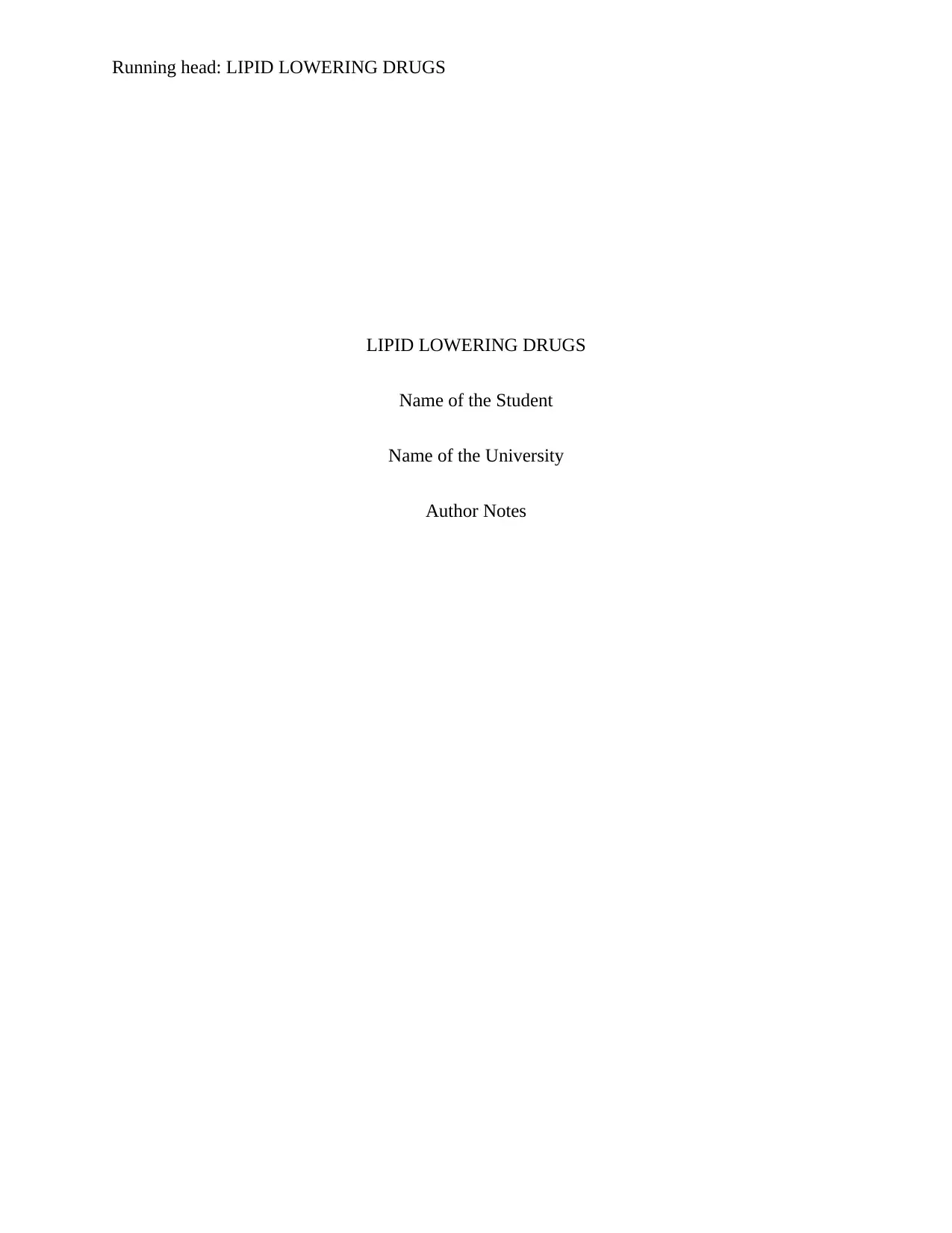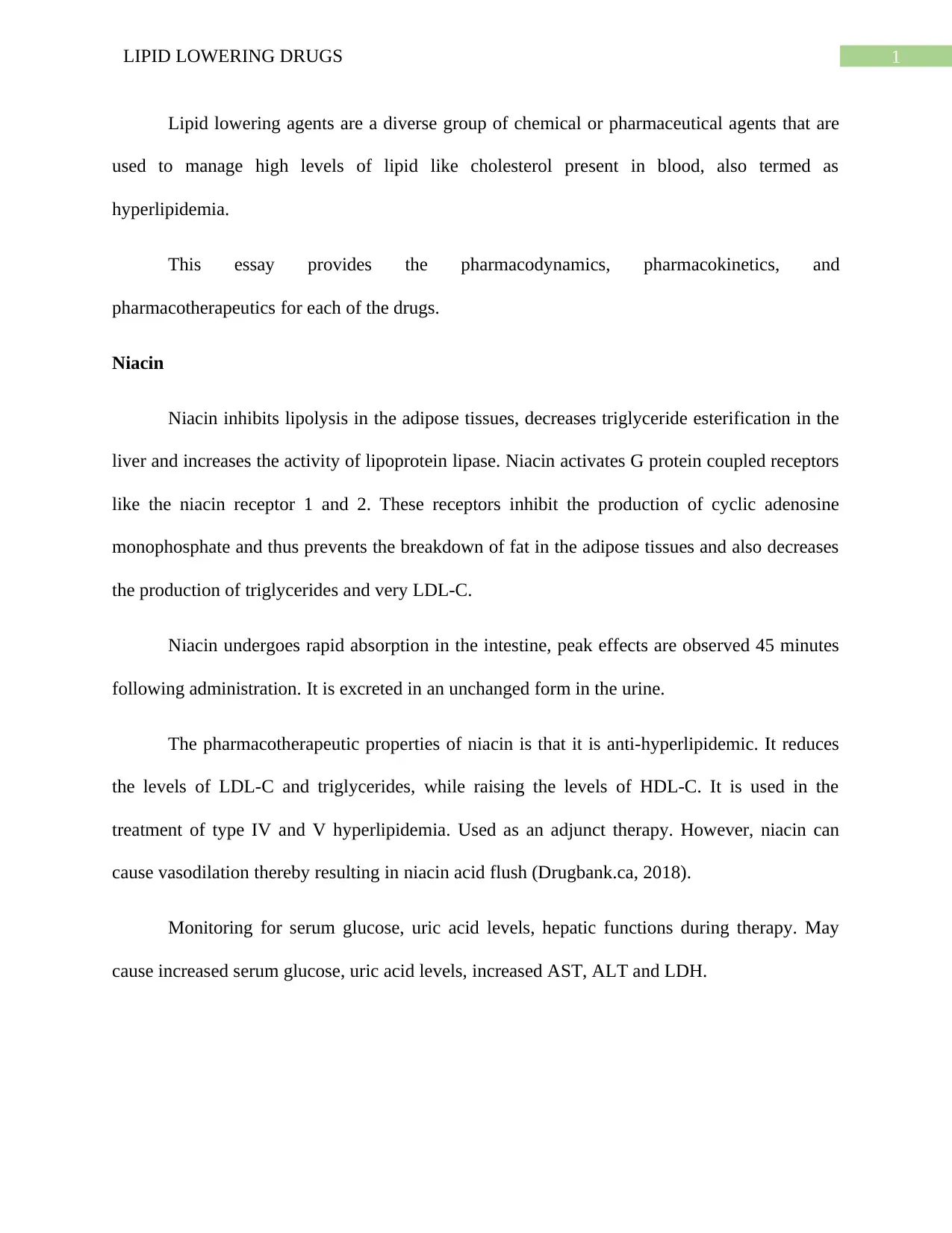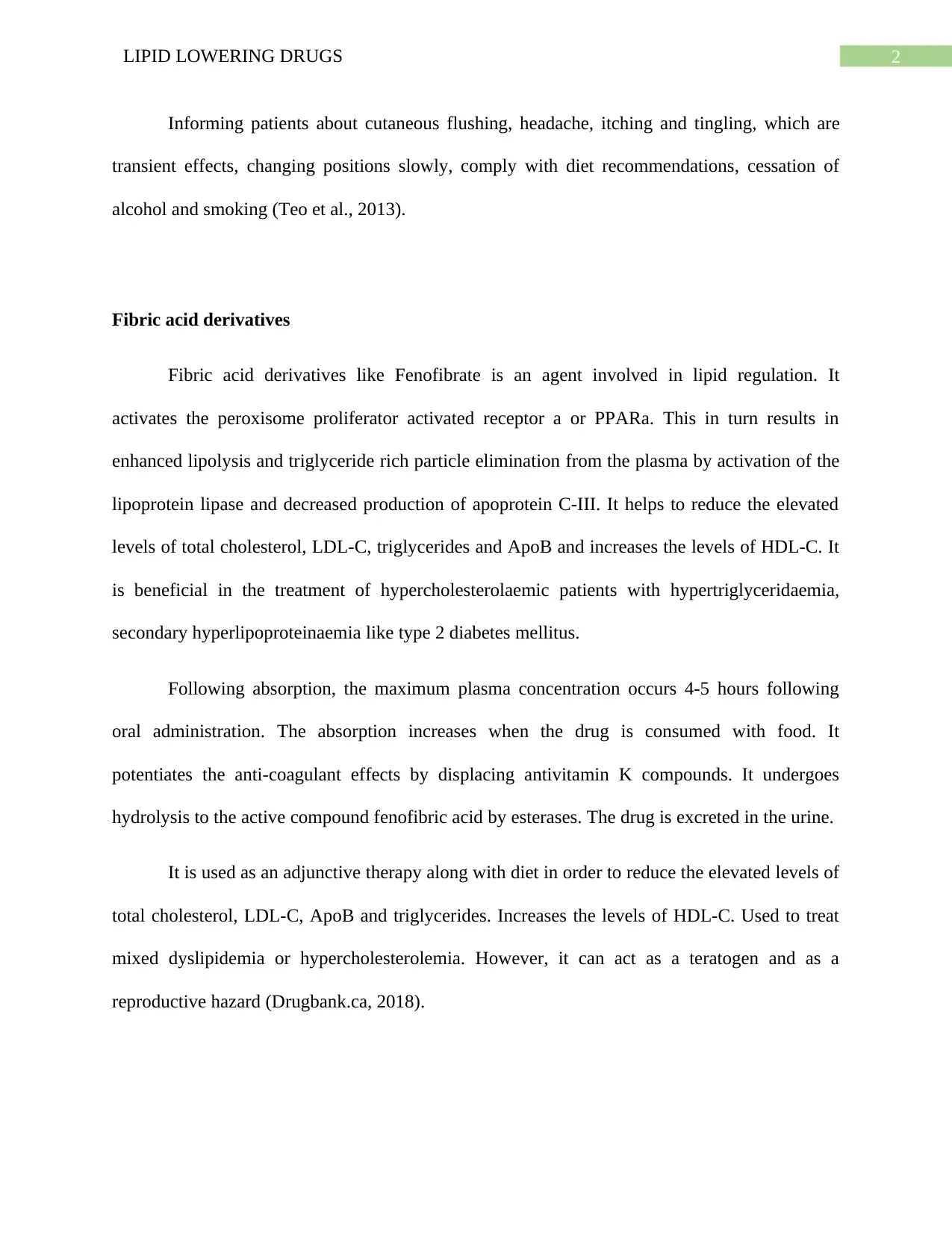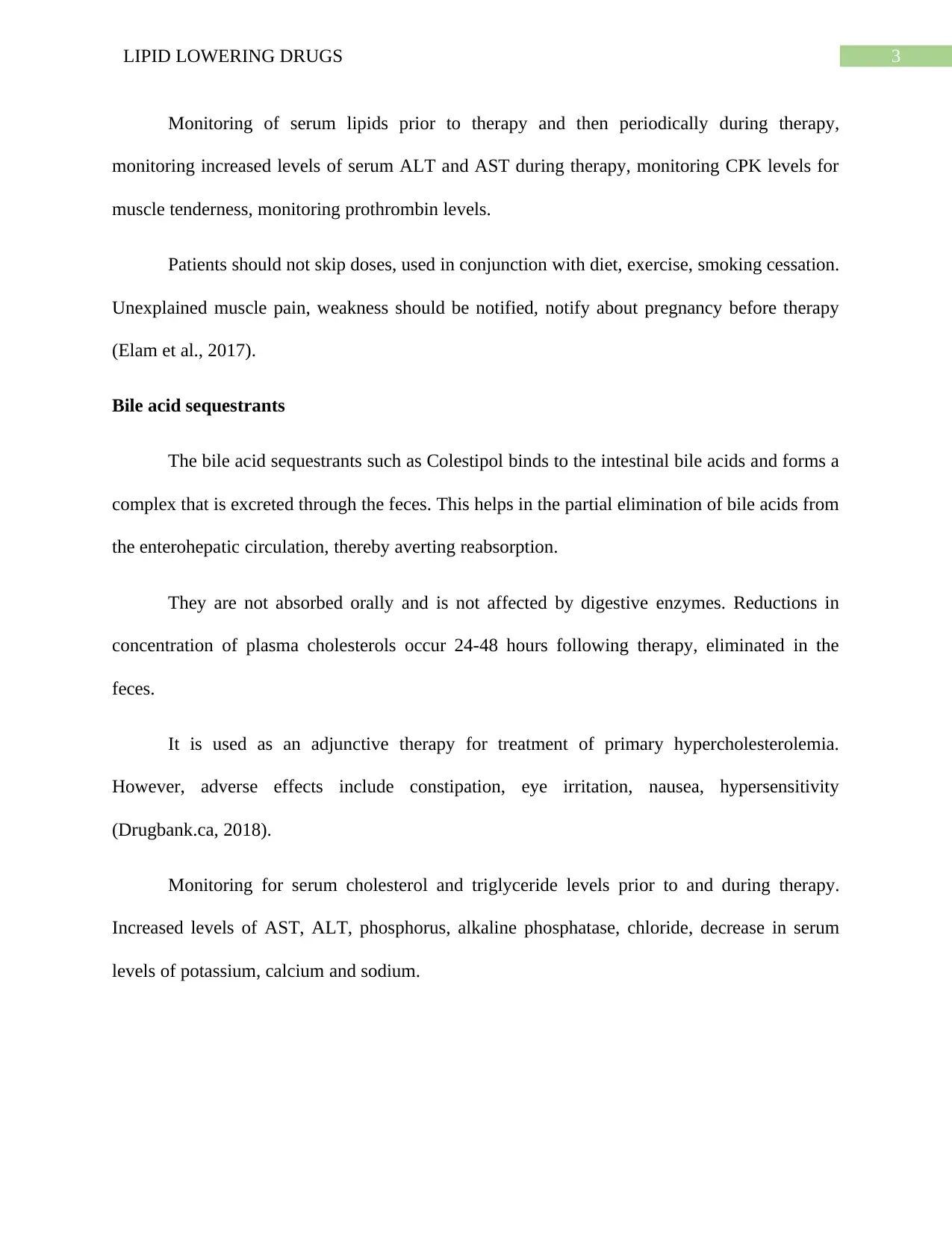Lipid Lowering Drugs: Pharmacodynamics, Pharmacokinetics, and Pharmacotherapeutics
VerifiedAdded on 2023/06/15
|8
|1332
|441
AI Summary
This essay provides the pharmacodynamics, pharmacokinetics, and pharmacotherapeutics for each of the lipid lowering drugs including niacin, fibric acid derivatives, bile acid sequestrants, and HMG-CoA reductase inhibitors.
Contribute Materials
Your contribution can guide someone’s learning journey. Share your
documents today.

Running head: LIPID LOWERING DRUGS
LIPID LOWERING DRUGS
Name of the Student
Name of the University
Author Notes
LIPID LOWERING DRUGS
Name of the Student
Name of the University
Author Notes
Secure Best Marks with AI Grader
Need help grading? Try our AI Grader for instant feedback on your assignments.

1LIPID LOWERING DRUGS
Lipid lowering agents are a diverse group of chemical or pharmaceutical agents that are
used to manage high levels of lipid like cholesterol present in blood, also termed as
hyperlipidemia.
This essay provides the pharmacodynamics, pharmacokinetics, and
pharmacotherapeutics for each of the drugs.
Niacin
Niacin inhibits lipolysis in the adipose tissues, decreases triglyceride esterification in the
liver and increases the activity of lipoprotein lipase. Niacin activates G protein coupled receptors
like the niacin receptor 1 and 2. These receptors inhibit the production of cyclic adenosine
monophosphate and thus prevents the breakdown of fat in the adipose tissues and also decreases
the production of triglycerides and very LDL-C.
Niacin undergoes rapid absorption in the intestine, peak effects are observed 45 minutes
following administration. It is excreted in an unchanged form in the urine.
The pharmacotherapeutic properties of niacin is that it is anti-hyperlipidemic. It reduces
the levels of LDL-C and triglycerides, while raising the levels of HDL-C. It is used in the
treatment of type IV and V hyperlipidemia. Used as an adjunct therapy. However, niacin can
cause vasodilation thereby resulting in niacin acid flush (Drugbank.ca, 2018).
Monitoring for serum glucose, uric acid levels, hepatic functions during therapy. May
cause increased serum glucose, uric acid levels, increased AST, ALT and LDH.
Lipid lowering agents are a diverse group of chemical or pharmaceutical agents that are
used to manage high levels of lipid like cholesterol present in blood, also termed as
hyperlipidemia.
This essay provides the pharmacodynamics, pharmacokinetics, and
pharmacotherapeutics for each of the drugs.
Niacin
Niacin inhibits lipolysis in the adipose tissues, decreases triglyceride esterification in the
liver and increases the activity of lipoprotein lipase. Niacin activates G protein coupled receptors
like the niacin receptor 1 and 2. These receptors inhibit the production of cyclic adenosine
monophosphate and thus prevents the breakdown of fat in the adipose tissues and also decreases
the production of triglycerides and very LDL-C.
Niacin undergoes rapid absorption in the intestine, peak effects are observed 45 minutes
following administration. It is excreted in an unchanged form in the urine.
The pharmacotherapeutic properties of niacin is that it is anti-hyperlipidemic. It reduces
the levels of LDL-C and triglycerides, while raising the levels of HDL-C. It is used in the
treatment of type IV and V hyperlipidemia. Used as an adjunct therapy. However, niacin can
cause vasodilation thereby resulting in niacin acid flush (Drugbank.ca, 2018).
Monitoring for serum glucose, uric acid levels, hepatic functions during therapy. May
cause increased serum glucose, uric acid levels, increased AST, ALT and LDH.

2LIPID LOWERING DRUGS
Informing patients about cutaneous flushing, headache, itching and tingling, which are
transient effects, changing positions slowly, comply with diet recommendations, cessation of
alcohol and smoking (Teo et al., 2013).
Fibric acid derivatives
Fibric acid derivatives like Fenofibrate is an agent involved in lipid regulation. It
activates the peroxisome proliferator activated receptor a or PPARa. This in turn results in
enhanced lipolysis and triglyceride rich particle elimination from the plasma by activation of the
lipoprotein lipase and decreased production of apoprotein C-III. It helps to reduce the elevated
levels of total cholesterol, LDL-C, triglycerides and ApoB and increases the levels of HDL-C. It
is beneficial in the treatment of hypercholesterolaemic patients with hypertriglyceridaemia,
secondary hyperlipoproteinaemia like type 2 diabetes mellitus.
Following absorption, the maximum plasma concentration occurs 4-5 hours following
oral administration. The absorption increases when the drug is consumed with food. It
potentiates the anti-coagulant effects by displacing antivitamin K compounds. It undergoes
hydrolysis to the active compound fenofibric acid by esterases. The drug is excreted in the urine.
It is used as an adjunctive therapy along with diet in order to reduce the elevated levels of
total cholesterol, LDL-C, ApoB and triglycerides. Increases the levels of HDL-C. Used to treat
mixed dyslipidemia or hypercholesterolemia. However, it can act as a teratogen and as a
reproductive hazard (Drugbank.ca, 2018).
Informing patients about cutaneous flushing, headache, itching and tingling, which are
transient effects, changing positions slowly, comply with diet recommendations, cessation of
alcohol and smoking (Teo et al., 2013).
Fibric acid derivatives
Fibric acid derivatives like Fenofibrate is an agent involved in lipid regulation. It
activates the peroxisome proliferator activated receptor a or PPARa. This in turn results in
enhanced lipolysis and triglyceride rich particle elimination from the plasma by activation of the
lipoprotein lipase and decreased production of apoprotein C-III. It helps to reduce the elevated
levels of total cholesterol, LDL-C, triglycerides and ApoB and increases the levels of HDL-C. It
is beneficial in the treatment of hypercholesterolaemic patients with hypertriglyceridaemia,
secondary hyperlipoproteinaemia like type 2 diabetes mellitus.
Following absorption, the maximum plasma concentration occurs 4-5 hours following
oral administration. The absorption increases when the drug is consumed with food. It
potentiates the anti-coagulant effects by displacing antivitamin K compounds. It undergoes
hydrolysis to the active compound fenofibric acid by esterases. The drug is excreted in the urine.
It is used as an adjunctive therapy along with diet in order to reduce the elevated levels of
total cholesterol, LDL-C, ApoB and triglycerides. Increases the levels of HDL-C. Used to treat
mixed dyslipidemia or hypercholesterolemia. However, it can act as a teratogen and as a
reproductive hazard (Drugbank.ca, 2018).

3LIPID LOWERING DRUGS
Monitoring of serum lipids prior to therapy and then periodically during therapy,
monitoring increased levels of serum ALT and AST during therapy, monitoring CPK levels for
muscle tenderness, monitoring prothrombin levels.
Patients should not skip doses, used in conjunction with diet, exercise, smoking cessation.
Unexplained muscle pain, weakness should be notified, notify about pregnancy before therapy
(Elam et al., 2017).
Bile acid sequestrants
The bile acid sequestrants such as Colestipol binds to the intestinal bile acids and forms a
complex that is excreted through the feces. This helps in the partial elimination of bile acids from
the enterohepatic circulation, thereby averting reabsorption.
They are not absorbed orally and is not affected by digestive enzymes. Reductions in
concentration of plasma cholesterols occur 24-48 hours following therapy, eliminated in the
feces.
It is used as an adjunctive therapy for treatment of primary hypercholesterolemia.
However, adverse effects include constipation, eye irritation, nausea, hypersensitivity
(Drugbank.ca, 2018).
Monitoring for serum cholesterol and triglyceride levels prior to and during therapy.
Increased levels of AST, ALT, phosphorus, alkaline phosphatase, chloride, decrease in serum
levels of potassium, calcium and sodium.
Monitoring of serum lipids prior to therapy and then periodically during therapy,
monitoring increased levels of serum ALT and AST during therapy, monitoring CPK levels for
muscle tenderness, monitoring prothrombin levels.
Patients should not skip doses, used in conjunction with diet, exercise, smoking cessation.
Unexplained muscle pain, weakness should be notified, notify about pregnancy before therapy
(Elam et al., 2017).
Bile acid sequestrants
The bile acid sequestrants such as Colestipol binds to the intestinal bile acids and forms a
complex that is excreted through the feces. This helps in the partial elimination of bile acids from
the enterohepatic circulation, thereby averting reabsorption.
They are not absorbed orally and is not affected by digestive enzymes. Reductions in
concentration of plasma cholesterols occur 24-48 hours following therapy, eliminated in the
feces.
It is used as an adjunctive therapy for treatment of primary hypercholesterolemia.
However, adverse effects include constipation, eye irritation, nausea, hypersensitivity
(Drugbank.ca, 2018).
Monitoring for serum cholesterol and triglyceride levels prior to and during therapy.
Increased levels of AST, ALT, phosphorus, alkaline phosphatase, chloride, decrease in serum
levels of potassium, calcium and sodium.
Secure Best Marks with AI Grader
Need help grading? Try our AI Grader for instant feedback on your assignments.

4LIPID LOWERING DRUGS
Patients instructed to not miss doses, consume before meals, used in conjunction with
diet, exercise and smoking cessation, increased fluid intake, notify for unusual bleeding, tarry
stool (Dayer-Berenson, Finckenor & Tuzzolino, 2014).
HMG-CoA reductase inhibitors
Reduces total cholesterol and LDL-C, apoB, triglyceride levels and increases HDL-C.
Reduces the risk of cardiovascular diseases. Selectively inhibits the hepatic enzyme HMG-CoA
reductase, decreased hepatic cholesterol levels, increases uptake of LDL-C, reduces serum
concentrations of LDL-C.
It is highly soluble and is absorbed after oral administration, oral bioavailability is 14%,
98% plasma protein binding, undergoes oxidation, lactonisation and glucuronidation in the liver
and gut. Metabolites excreted by biliary secretion and also by direct secretion to the intestine.
Helps in the prevention of coronary heart disease in individuals and also helps to prevent
stroke, angina, myocardial infarction. Treatment of primary hypercholesterolemia, mixed
dyslipidemia, primary dysbetalipoproteinemia, homozygous familial hypercholesterolemia, and
hypertriglyceridemia. However adverse effects include myalgia, asthenia, constipation, nausea,
abdominal pain, hepatotoxicity and myotoxicity (Drugbank.ca, 2018).
Monitoring serum cholesterol and triglyceride levels prior to and during therapy.
Monitoring of liver function tests before therapy. Increased alkaline phosphatase and bilirubin
levels, hyperbilirubinemia, jaundice. Monitoring for immune mediated necrotizing myopathy.
Patients are to take missed doses in conjunction with diet, exercise, smoking cessation,
notify healthcare professionals for adverse events, should not taken during pregnancy or breast
feeding (Sorrentino, 2012).
Patients instructed to not miss doses, consume before meals, used in conjunction with
diet, exercise and smoking cessation, increased fluid intake, notify for unusual bleeding, tarry
stool (Dayer-Berenson, Finckenor & Tuzzolino, 2014).
HMG-CoA reductase inhibitors
Reduces total cholesterol and LDL-C, apoB, triglyceride levels and increases HDL-C.
Reduces the risk of cardiovascular diseases. Selectively inhibits the hepatic enzyme HMG-CoA
reductase, decreased hepatic cholesterol levels, increases uptake of LDL-C, reduces serum
concentrations of LDL-C.
It is highly soluble and is absorbed after oral administration, oral bioavailability is 14%,
98% plasma protein binding, undergoes oxidation, lactonisation and glucuronidation in the liver
and gut. Metabolites excreted by biliary secretion and also by direct secretion to the intestine.
Helps in the prevention of coronary heart disease in individuals and also helps to prevent
stroke, angina, myocardial infarction. Treatment of primary hypercholesterolemia, mixed
dyslipidemia, primary dysbetalipoproteinemia, homozygous familial hypercholesterolemia, and
hypertriglyceridemia. However adverse effects include myalgia, asthenia, constipation, nausea,
abdominal pain, hepatotoxicity and myotoxicity (Drugbank.ca, 2018).
Monitoring serum cholesterol and triglyceride levels prior to and during therapy.
Monitoring of liver function tests before therapy. Increased alkaline phosphatase and bilirubin
levels, hyperbilirubinemia, jaundice. Monitoring for immune mediated necrotizing myopathy.
Patients are to take missed doses in conjunction with diet, exercise, smoking cessation,
notify healthcare professionals for adverse events, should not taken during pregnancy or breast
feeding (Sorrentino, 2012).

5LIPID LOWERING DRUGS

6LIPID LOWERING DRUGS
Reference List
Dayer-Berenson, L., Finckenor, M., & Tuzzolino, M. (2014). Are add-on agents to statin therapy
necessary in hypercholesterolemia?. Clinical Lipidology, 9(6), 695-707.
Drugbank.ca. (2018). Atorvastatin - DrugBank. Drugbank.ca. Retrieved 17 February 2018, from
https://www.drugbank.ca/drugs/DB01076
Drugbank.ca. (2018). Colestipol - DrugBank. Drugbank.ca. Retrieved 17 February 2018, from
https://www.drugbank.ca/drugs/DB00375
Drugbank.ca. (2018). Fenofibrate - DrugBank. Drugbank.ca. Retrieved 17 February 2018, from
https://www.drugbank.ca/drugs/DB01039
Drugbank.ca. (2018). Niacin - DrugBank. Drugbank.ca. Retrieved 17 February 2018, from
https://www.drugbank.ca/drugs/DB00627
Elam, M. B., Ginsberg, H. N., Lovato, L. C., Corson, M., Largay, J., Leiter, L. A., ... &
Friedewald, W. T. (2017). Association of fenofibrate therapy with long-term
cardiovascular risk in statin-treated patients with type 2 diabetes. Jama cardiology, 2(4),
370-380.
Sorrentino, M. J. (2012). An update on statin alternatives and adjuncts. Clinical Lipidology, 7(6),
721-730.
Teo, K. K., Goldstein, L. B., Chaitman, B. R., Grant, S., Weintraub, W. S., Anderson, D. C., ... &
Boden, W. E. (2013). Extended-Release Niacin Therapy and Risk of Ischemic Stroke in
Patients With Cardiovascular Disease: The Atherothrombosis Intervention in Metabolic
Reference List
Dayer-Berenson, L., Finckenor, M., & Tuzzolino, M. (2014). Are add-on agents to statin therapy
necessary in hypercholesterolemia?. Clinical Lipidology, 9(6), 695-707.
Drugbank.ca. (2018). Atorvastatin - DrugBank. Drugbank.ca. Retrieved 17 February 2018, from
https://www.drugbank.ca/drugs/DB01076
Drugbank.ca. (2018). Colestipol - DrugBank. Drugbank.ca. Retrieved 17 February 2018, from
https://www.drugbank.ca/drugs/DB00375
Drugbank.ca. (2018). Fenofibrate - DrugBank. Drugbank.ca. Retrieved 17 February 2018, from
https://www.drugbank.ca/drugs/DB01039
Drugbank.ca. (2018). Niacin - DrugBank. Drugbank.ca. Retrieved 17 February 2018, from
https://www.drugbank.ca/drugs/DB00627
Elam, M. B., Ginsberg, H. N., Lovato, L. C., Corson, M., Largay, J., Leiter, L. A., ... &
Friedewald, W. T. (2017). Association of fenofibrate therapy with long-term
cardiovascular risk in statin-treated patients with type 2 diabetes. Jama cardiology, 2(4),
370-380.
Sorrentino, M. J. (2012). An update on statin alternatives and adjuncts. Clinical Lipidology, 7(6),
721-730.
Teo, K. K., Goldstein, L. B., Chaitman, B. R., Grant, S., Weintraub, W. S., Anderson, D. C., ... &
Boden, W. E. (2013). Extended-Release Niacin Therapy and Risk of Ischemic Stroke in
Patients With Cardiovascular Disease: The Atherothrombosis Intervention in Metabolic
Paraphrase This Document
Need a fresh take? Get an instant paraphrase of this document with our AI Paraphraser

7LIPID LOWERING DRUGS
Syndrome With Low HDL/High Triglycerides: Impact on Global Health Outcome (AIM–
HIGH) Trial. Stroke, 44(10), 2688-2693.
Syndrome With Low HDL/High Triglycerides: Impact on Global Health Outcome (AIM–
HIGH) Trial. Stroke, 44(10), 2688-2693.
1 out of 8
Your All-in-One AI-Powered Toolkit for Academic Success.
+13062052269
info@desklib.com
Available 24*7 on WhatsApp / Email
![[object Object]](/_next/static/media/star-bottom.7253800d.svg)
Unlock your academic potential
© 2024 | Zucol Services PVT LTD | All rights reserved.
